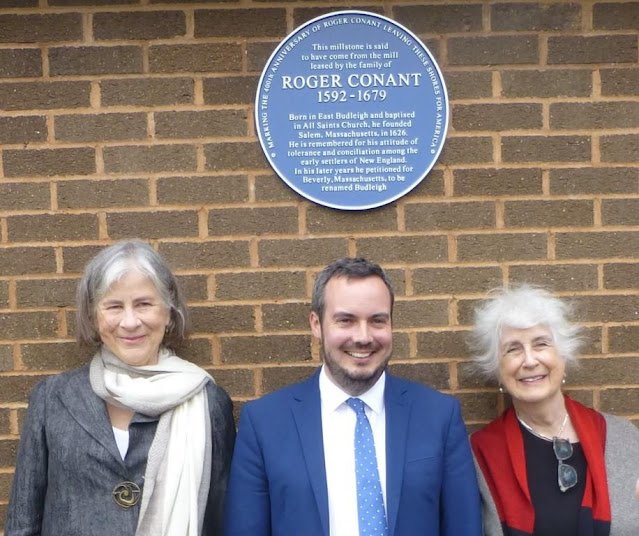On Friday 12 May this year, local MP Simon Jupp was joined by two American descendants of Roger Conant in a formal unveiling of a blue plaque at East Budleigh’s Church Hall.
The event had been arranged to honour the East Budleigh-born founder of the American city of Salem in Massachusetts, as Mr Jupp explained in a speech. The unveiling was followed by dinner in the Sir Walter Raleigh pub for around 30 guests.
East Budleigh’s Roger Conant Club was formed recently to raise awareness of this early European settler in the run-up to the 400th anniversary of Salem’s founding. Along with the blue plaque a fine painting by local artist John Washington is now displayed in All Saints Church. It depicts a moment in early American history when Conant intervened as a peacemaker in a potentially violent quarrel between West Country fishermen and a group of armed soldiers from Plymouth Colony commanded by the Mayflower Pilgrims’ military advisor Myles Standish.
The Roger Conant Club is in contact with an increasing number of American descendants keen to discover more about the Devonian origins of their ancestor. Contact has also been made with the First Church in Salem, of which Conant was one of the founding members. ‘We celebrate him regularly as the founder of Naumkeag – the original Indian name for Salem – and for his relationship to the indigenous people of Cape Ann,’ says the First Church’s archivist Diane Smith. Roger Conant is celebrated for his role in the peaceful transfer of power to John Endicott, the longest-serving governor of the Massachusetts Bay Colony, which became the Commonwealth of Massachusetts.
East Budleigh historian Ian Blackwell is currently engaged in research for a book about this former village resident, less well known than Sir Walter Raleigh, and of a different character.
Meanwhile, across the Atlantic, Roger Conant features prominently in a book, The Founding of Salem, City of Peace, published last year by Salem resident Benjamin Shallop. For Shallop, this early European settler stands out among his contemporaries in 17th century America.
‘Roger Conant himself does appear to be that rare colonial figure who isn’t very problematic,’ he writes. ‘He maintained good relationships with the native people he encountered, he was a leader of marginalized people within the Plymouth and later Massachusetts Bay Colonies (namely the working folks who were not necessarily Puritans), he succeeded through peaceful means and compromise, and more. He is a man that I think any generation can celebrate for all of that.’
Credit: John Andrews
Salem itself is unhappily known as the Witch City thanks to the infamous trials for witchcraft which took place some 13 years after Roger Conant's death. More than 200 people were accused in an episode of mass hysteria, resulting in the execution of 19 innocent victims. Shameful as the event was, it has contributed significantly to the city's tourism industry, such is people's fascination with the occult.
This famous statue of Roger Conant was unfortunately sited outside Salem's Witch Museum, leading some visitors to believe that Roger himself was involved with witchcraft!
The approach of Salem's 400th and a renewed focus by historians on the life of its founder may well lead to increased interest in other notable members of this local family, some of whom played a part in the religious and political turmoil of his times.
Roger's brother, John Conant, vicar of Lymington in Somerset, is remembered for his address to the Westminster Assembly of Divines in 1643. His nephew Richard Conant was vicar of East Budleigh. Another, more celebrated nephew was the theologian Dr John Conant who became Vice-Chancellor of Oxford University.




